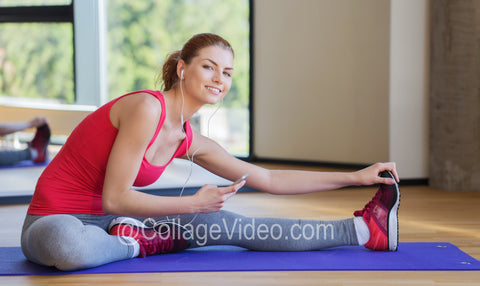Foam Roller Exercises for Your Lower Body
by Jari Love
Foam rolling helps to massage the body, loosening up tight and stiff muscles, which is a must for preventing injury. Here are 7 foam rolling exercises to try after your workout.
IT Band
– Lying on your side, similar to a side plank position, place the roller on the outside of your thigh just below your hip.
– Place your top arm on your hip, and using your top leg for stability, roll the length of your thigh, stopping just above the knee. Go slowly, and do not roll over the knee joint. Keep your bottom leg lifted, or lower it down to the floor if you can. Chances are high that this move will be painful, which is a sign that you really need to do this.
– If you find an especially tender point, try rolling forward and back to release this spot.
– Roll for 30 to 60 seconds, then switch sides.
Tip: the IT band is a thick strand of fascia that runs the length of the thigh; when it gets tight, it can pull the knee out of alignment, causing pain and inflammation in the joint.
Calves
– Sit on the floor with your left ankle crossed over your right, and place the roller under your right calf.
– Lift your pelvis off the ground so your weight is supported by your hands and the roller.
– Roll the length of your calf, from the back of your knee to the Achilles tendon. Do roll the inside and the outside of the muscle as well.
– Repeat for 30 to 60 seconds, then switch legs.
Tip: pay special attention to tight spots, allowing the tension to sink into the roller.
Glutes
– Lying on the floor, lift your legs, and place the roller at the back of your pelvis (aka sacrum).
– Gripping the end of the roller for stability, slowly twist your lower body to the left, then to the right, to massage your glutes. Continue for 30 to 60 seconds.
– Adjust your body’s position until you find the “sweet spot” or tight spot. Direct pressure will help to release knots.
Tip: tight glutes can pull on the IT band and adversely affect the alignment of the hips and knees.
Shins
– Starting on all fours, place the roller directly on your shins.
– Keeping your hands grounded, roll your knees toward your hands, stopping the roller right above the ankles. A slight twist will allow you to reach the entire muscle.
– Roll for 30 to 60 seconds.
Tip: this move is a key to preventing shin splints.
Piriformis
– Sitting on the floor, place the roller in the middle of your glutes.
– Using a short and steady roll, move the roller back and forth for 30 to 60 seconds.
– To reach the entire muscle, adjust your position from side to side. Apply active release on specific tight spots by holding still for five seconds.
Tip: the piriformis muscle, found under the glute max, runs laterally from the sacrum (back of the pelvis) to the outside of the upper thigh. It is small but can get really tight.
Lower Back
– Sitting on the ground, lift your pelvis off the floor to place the foam roller directly in the small of your lower back.
– Using your right hand for stability, roll up and down the length of your lower back for 30 to 60 seconds. Do be mindful of your spine.
– Slightly tilt from side to side to reach the entire area.
Tip: keeping your lower back loose and limber directly affects the flexibility of your glutes and the efficiency of your training.
Quads
– Resting on your stomach, place the roller under the front of your thighs, lifting yourself into a basic plank position on your elbows.
– Pull with your arms to roll up and down the length of the quad. Do not roll over your knee joint.
– Continue this movement for 30 to 60 seconds.
For images on these foam rolling exercises, visit popsugar.com.
Jari Love – original creator of Get RIPPED! DVD series and group exercise classes. The hot-selling and critically acclaimed Get RIPPED! series enables individuals of any fitness level to burn up to three times more calories than the traditional weight-training program, and has received rave reviews from fitness critics throughout North America since the first title debuted in late 2005.










